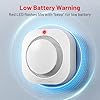A heat detector is a device that detects the presence of heat in an area. Heat detectors are used in a variety of applications, including fire detection, security, and industrial process control.
Heat detectors are used in a variety of places, depending on the type of detector. Some common places are in factories, schools, and other large buildings. They are also used in homes, usually in the kitchen or near the furnace.
Here are some of the commin places to put heat detector:
Contents
In the Kitchen
The kitchen is full of potential fire hazards. From the stovetop to the oven to the toaster, there are many ways a fire can start in the kitchen. Heat detectors are a great way to protect your home from these potential hazards.
In the Bathroom
When it comes to using heat detectors in the bathroom, there are two main types of heat detectors that can be used. The first type is the point type heat detector, which is designed to be placed in a specific location in the room. The second type is the line type heat detector, which is designed to be placed along a line in the room.
The point type heat detector is the best choice for use in the bathroom. This type of heat detector is designed to be placed in a specific location in the room, such as near the shower or tub. The point type heat detector is able to detect the heat from the shower or tub and will activate the alarm when the temperature reaches a certain level.
The line type heat detector is not as effective as the point type heat detector in the bathroom. This type of heat detector is designed to be placed along a line in the room, such as along the floor. The line type heat detector is not able to detect the heat from the shower or tub and will only activate the alarm when the temperature in the room reaches a certain level.
In the Bedroom
When it comes to bedrooms, the most important factor is usually comfort. This is why many people choose to use a heat detector in their bedroom. A heat detector can help to keep the room at a comfortable temperature by detecting when the temperature starts to rise. This can be especially useful during the summer months when the temperature can start to get uncomfortably hot.
In the Living Room
A heat detector is a device that is used to detect the presence of heat in an area. Heat detectors can be used in a variety of settings, including homes, businesses, and industrial facilities.
One of the most common places to use a heat detector is in the living room. Heat detectors can be used to detect the presence of a fire, or to monitor the temperature of the room. Heat detectors can be placed in the corners of the room, near windows, or near the fireplace. Heat detectors can also be placed in the center of the room, or in any other location where they can best detect the presence of heat.
Heat detectors are an important part of any home security system. Heat detectors can be used to detect the presence of a fire, or to monitor the temperature of the room. Heat detectors can be placed in the corners of the room, near windows, or near the fireplace. Heat detectors can also be placed in the center of the room, or in any other location where they can best detect the presence of heat.
In the Garage
If you have a garage, you should install a heat detector in there. A fire in the garage can quickly spread to the rest of the house, so it’s important to have an early warning system. The heat detector will alert you to the fire so you can take action to extinguish it or evacuate the premises.
In the Attic
A heat detector is a device that is used to detect the presence of heat. There are two types of heat detectors: those that detect the presence of heat, and those that measure the temperature. The most common type of heat detector is the former, which is used in a variety of applications, including fire alarm systems.
The most common use for heat detectors is in fire alarm systems. Heat detectors are typically installed in areas where fires are most likely to start, such as in kitchens and near flammable materials. When the heat detector senses a rise in temperature, it triggers the alarm system, which alerts the authorities and allows for a prompt response.
Heat detectors can also be used in a variety of other applications. For example, they can be used in industrial settings to monitor machinery and process temperatures. They can also be used in HVAC systems to monitor the temperature of air ducts and prevent the spread of fires.
When choosing a heat detector, it is important to select one that is appropriate for the application. For example, fire alarm systems require heat detectors that are sensitive to high temperatures and can respond quickly. HVAC applications, on the other hand, may only require heat detectors that can measure lower temperatures.
Heat detectors are an important part of fire safety systems and can be used in a variety of applications. They are most commonly used in fire alarm systems, but can also be used in other settings, such as industrial plants and HVAC systems.
In the Basement
When it comes to your basement, a heat detector is an ideal way to monitor for fires. This is because basements are often filled with flammable materials, such as wood beams, insulation, and paper products. By having a heat detector in your basement, you can be alerted to a fire before it has a chance to spread.
In addition to the basement, heat detectors are also a good choice for bedrooms, kitchens, and laundry rooms. These are all areas of the home where fires are likely to start, and where people are likely to be sleeping or working. By having a heat detector in these rooms, you can be sure that you will be alerted to a fire as soon as it starts.
Summary
There are many places where a heat detector can be used, such as in a home, office, or factory. Heat detectors are devices that detect the presence of heat and can be used to warn of a fire.



















